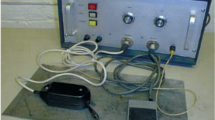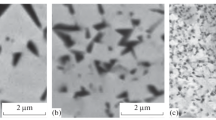Abstract
We have studied the erosion characteristics of hard alloys under electrospark alloying conditions, and the relationship of such characteristics with the physical and mechanical properties. WC – 16% Co alloys were obtained by conventional sintering under vacuum in the temperature range 950-1350°C, and by sintering followed by high-energy pressure treatment at the same temperatures. We have shown that the erosion resistance depends ambiguously on the porosity and bending strength but is quite clearly connected with the crack resistance and the electrical resistivity which in turn is determined by the quality of the interphase and intergrain boundaries. We have refined the structural dependence of the erosion resistance of hard-alloy electrodes. This dependence is manifested to the same extent as the structural dependence of the electrical resistance.
Similar content being viewed by others
REFERENCES
A. D. Verkhoturov, I. A. Podchernyaeva, L. F. Pryadko, and F. F. Egorov, Electrode Materials for Electrospark Alloying [in Russian], Nauka, Moscow (1988).
I. M. Mukha, A. D. Verkhoturov, and S. V. Gnedova, “Material for alloying electrodes based on WC–Co hard alloys with boron microadditives,” Élektron. Obrab. Materialov, No. 4, 24-27 (1981).
A. D. Verkhoturov and I. M. Mukha, Electrospark Alloying Technology [in Russian], Tekhnika, Kiev (1982).
L. A. Bakuto and M. K. Mitskevich, “Factors affecting formation of coatings in the electrospark machining method,” Élektron. Obrab. Materialov, No. 3, 17-19 (1977).
K. Jia, T. E. Fischer, and B. Gallois, “Microstructure, hardness and toughness of nanostructured and conventional WC–Co composites,” Nanostructured Mat., 10, No. 5, 876-891 (1998).
G. Gille, B. Szesny, K. Dreyer, et al., “Submicron and ultrafine grained hard metal for microdrills and metal cutting insert,” in: Proceedings, Fifteenth International Plansee Seminar(Reutte, Tirol, Austria), Reutte, Tirol (2001), Vol. 2, pp. 782-816.
A. D. Verkhoturov, S. N. Kirilenko, and V. T. Bondar', “Study of the process of electrospark alloying of steels with WC–Co hard alloys,” Poroshk. Metall., No. 8, 67-71 (1980).
Yu. G. Tkachenko, É. P. Ignatenko, G. A. Bovkun, et al., “Effect of the anode structure on characteristics of electrospark hardening by hard alloys,” Élektron. Obrab. Materialov, No. 4, 21-24 (1981).
S. N. Kirilenko, Development of Sintered Electrode Materials Made from Titanium Carbide and Tungsten Carbide Alloys for Electrospark Alloying of Steels Followed by Additional Processing, PhD Thesis [in Russian], Kiev (1989).
M. S. Kovalchenko, A. V. Paustovsky, and V. P. Botvinko, “Increase in durability of high-speed steel cutting tools by spark hardening with subsequent laser treatment,” Func. Mat., 8, No. 1, 1-5 (2001).
S. V. Tverdokhlebova, “Characteristic features of electrospark erosion of composite materials,” Izv. Vuzov. Chernaya Metallurgiya, No. 3, 50-55 (1997).
A. V. Laptev, S. S. Ponomarev, and L. F. Ochkas, “Solid-phase consolidation of fine-grained WC–16% Co hard alloy,” J. Adv. Mat., 33, No. 3, 42-51 (2001).
G. A. Bovkun, M. S. Kovalchenko, A. V. Laptev, and Yu. G. Tkachenko, “Development of electrode WC-based materials for wear-resistant spark coating,” in: Proceedings, EURO PM'99 Conference on Advances in Hard Materials Production (November 8–10, 1999, Turin, Italy), Turin (1999), pp. 533-538.
H. E. Exner, “Understanding the toughness and the strength of WC–Co hard alloys,” in: Proceedings, 1996 European Conference on Advances in Hard Materials Production (1996, Stockholm), Stockholm (1996), pp. 255-262.
W. D. Schubert, H. Neumeister, G. Kinger, and B. Lux, “Hardness to toughness relationship of fine-grained WC–Co hard metals,” in: Proceedings, Fourteenth International Plansee Seminar'97 (May 12–16, 1997, Reutte, Tirol, Austria), Reutte, Tirol (1997), Vol. 4, pp. 249-264.
S. S. Gorelik, V. P. Elyutin, E. I. Mozzhukhin, et al., “X-ray diffraction study of processes of recrystallization of titanium, zirconium, and molybdenum borides and titanium and tungsten carbides,” Izv. Vuzov. Tsvet. Metallurgiya, No. 4, 143-148 (1962).
I. N. Chaporova and K. S. Chernyavskii, Structure of Sintered Hard Alloys [in Russian], Metallurgiya, Moscow (1975).
A. V. Laptev, S. S. Ponomarev, and L. F. Ochkas, “Characteristic features of the structure and properties of WC–16% Co alloy obtained by hot pressing in solid and liquid phases. I. Effect of the temperature at which the specimens are obtained on their density and structure,” Poroshk. Metall., Nos. 11–12, 103-116 (2000).
A. V. Laptev, S. S. Ponomarev, and L. F. Ochkas, “Study of possibility of solid phase producting poreless WC–26% Co hard metal at high energy pressing,” Proceedings, EURO PM'99 Conference on Advances in Hard Materials Production (November 8–10, 1999, Turin, Italy), Turin (1999), pp. 205-212.
V. V. Skorokhod, “Theory of the physical properties of porous and composite materials and the principles for controlling their microstructure in production processes,” Poroshk. Metall., Nos. 1–2, 53-71 (1995).
Author information
Authors and Affiliations
Rights and permissions
About this article
Cite this article
Bovkun, G.A., Laptev, A.V. Relationship between Erosion and Mechanical Characteristics of Fine-Grained Hard Alloy WC – 16% Co Obtained by Solid-Phase and Liquid-Phase Consolidation. Part 1. Erosion Resistance. Powder Metallurgy and Metal Ceramics 43, 265–272 (2004). https://doi.org/10.1023/B:PMMC.0000042461.02431.22
Issue Date:
DOI: https://doi.org/10.1023/B:PMMC.0000042461.02431.22




